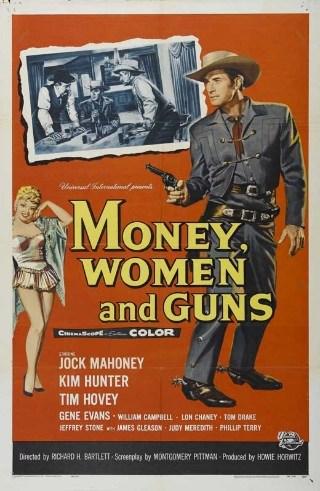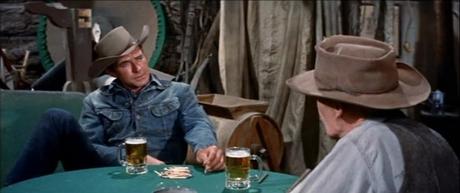
What's in a title? Sometimes a lot and other times very little. On the most fundamental level, it's one of the most prominent hooks upon which to hang a movie, or at least one's expectations of a movie. It may encourage a sense of what's coming up, tease you with anticipation or, if handled clumsily, dampen your enthusiasm. If successful, it will have conjured images in your mind, kindled a flame of curiosity and drawn you in. So what of a title such as 1958's Money, Women and Guns? Does it paint visions of some freewheeling adventure, full of action and eye candy but not all that much depth? I ask this because that's something like the way I first approached the film, but the reality is a little different. The title grabbed my attention, the opening even looked as though it might be bang on, and then the rest of the movie delivered quite a bit more.
It all begins on location in Lone Pine, with a botched robbery. Three masked men attempt to rob an ageing prospector, but make a poor job of it - two of them will die while the third is driven off by the mortally wounded miner. The incomplete or unclear dying declaration is one of the classic tropes of the mystery genre, the victim tantalizing us with broad hints towards the identity of his slayer before expiring. This time there's a little additional spin in that, before he dies, the old man makes it known that the perpetrator is named as one of the beneficiaries of his will. Superficially, that is what the story is about, the search for a killer from a short list of suspects. Up to this point it looks very much like a standard, formulaic tale, and that impression is strengthened further when we're introduced to the lead. "Silver" Ward Hogan (Jock Mahoney) is something straight out of a dime novel, a virtual caricature named for his fondness for silver bullets and accoutrements. Yet first impressions, like the pulpy title, prove to be misleading and the movies becomes much more interesting. Hogan is a detective retained by the prospector's lawyer to track down the beneficiaries of the will and, using that cover, bring in the surviving member of the gang. So Hogan sets out to locate the names on his list, to give the good news of an unexpected fortune to most, and the less welcome news of a day in court to one.

The film is structured in an episodic fashion, with series of vignettes providing the backdrop against which everything unfolds. It is, as I stated, a standard and quite absorbing mystery on the surface, but with a redemptive thread running through it all that is typical of the era. There is the journey Hogan is on towards personal fulfillment, something he will e seen to have attained by the fade out. As each little drama is played out in the course of his quest, we learn a little more about all those involved, about the motivations of the old man who made this rather odd will and the seemingly disparate group named within it. Essentially, it develops into a succession of moral fables which are telling, touching and not entirely predictable. By the end, it's the redemptive and restorative aspects that take precedence for us, even the discovery of the guilty party fits into this pattern and the result is a wonderfully positive experience. While the film never becomes overly sentimental, it does reinforce the better side of human nature and every negative consequence has a kernel of positivity within it. In short, you come away from this film with good feeling overall.
Richard Bartlett had already made the engaging with Jock Mahoney and again used the star's cool and relaxed persona perfectly. Along with cinematographer Philip Lathrop, he captured some terrific images from around Lone Pine and the whole movie looks very attractive inside the wide CinemaScope frame. However, it's that powerful thread of salvation which permeates Montgomery Pittman's script which stands out strongest and gives the film its heart.

I don't believe I've seen a western starring Jock Mahoney that I haven't enjoyed. He had such an easy-going and assured persona on the screen that you end up feeling confident yourself of what you're going to get. he role of the master detective fit him like a glove and he handled the action the scenes, the romantic interludes and the occasional light humor with great style, making the whole affair a pleasure to watch. Of course he benefited from having a solid cast working alongside him; Kim Hunter, who had a long and illustrious career from her beginnings with Val Lewton in The Seventh Victim through her Oscar-winning work with Kazan on A Streetcar Named Desire and on to cult immortality in Planet of the Apes, is an especially accomplished figure to play off, a classy lady who brings a great deal of charm and grace to a pivotal role. I think Tim Hovey did well too and came across convincingly, which isn't something you can always say about child actors. And there's quality all through the cast with Lon Chaney Jr, James Gleason, William Campbell, Gene Evans and Tom Drake all turning in credible or better performances.
Money, Women and Guns has been released on DVD in France and Spain but nowhere else, as far as I know. I've had the Spanish edition for some time and it's a good enough copy. It's presented in the correct anamorphic scope ratio and the print used is in pretty fair condition. Colors are stable and bright and the image doesn't suffer from much damage. There's a little softness from time to time, but nothing serious, and some of the process shots look a bit rough - overall, it's quite acceptable though. The disc, as usual, offers a choice of the original soundtrack or a Spanish dub and optional subs. Frankly, I think this is a delightful movie and one that is good for a number of viewings. That's not something you can say about too many films with a mystery at the heart of the script. However, Money, Women and Guns, aside from that superb title, features the kind of theme that goes beyond the more mechanical elements of the plot. Perhaps it's not all that well-known but I'd give it a recommendation.
